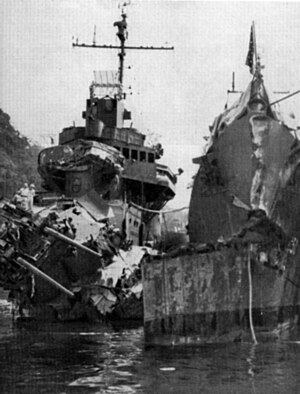Battle of Vella Lavella (naval)
This article includes a list of general references, but it lacks sufficient corresponding inline citations. (September 2014) |
| Battle of Vella Lavella | |||||||
|---|---|---|---|---|---|---|---|
| Part of the Pacific Theater of World War II | |||||||
 The destroyers USS Selfridge and O'Bannon at Noumea after the battle. | |||||||
| |||||||
| Belligerents | |||||||
|
|
| ||||||
| Commanders and leaders | |||||||
| Frank R. Walker | Matsuji Ijuin | ||||||
| Strength | |||||||
| 6 destroyers |
9 destroyers, 20 barges, auxiliary ships | ||||||
| Casualties and losses | |||||||
|
1 destroyer sunk, 2 destroyers heavily damaged, 64 killed 47 wounded 36 missing[1] |
1 destroyer sunk, 138 killed[2] | ||||||
The Battle of Vella Lavella (第二次ベララベラ海戦, Dainiji Berarabera kaisen) was a naval battle of the Pacific campaign of World War II fought on the night of 6 October 1943, near the island of Vella Lavella in the Solomon Islands.
Background
After their defeats on New Georgia and in the Battle of Vella Gulf, the Japanese had evacuated their garrisons in the central Solomons. A staging post had been established at Horaniu on the north tip of Vella Lavella for the evacuation barges. In October 1943, 600 soldiers remained, and a force of three older destroyer-transports - Fumizuki, Matsukaze, and Yūnagi - escorted by six modern fully combat-ready destroyers — Akigumo, Isokaze, Kazagumo, Yūgumo, Shigure, and Samidare — was dispatched under Rear Admiral Matsuji Ijuin to rescue them.
Battle
At 22:30, they spotted a U.S. force of three destroyers—Selfridge, Chevalier, and O'Bannon, commanded by Captain Frank R. Walker—approaching from Vella Gulf. A second division of three U.S. destroyers—Ralph Talbot, Taylor, and La Vallette— had been detached from convoy duty further South in the Solomons with orders to join up with Walker. These three additional ships were making speed up the west coast of Vella Lavella towards his division. Walker did not wait for his other three destroyers to come up, however, but attacked immediately. Both sides launched torpedoes and opened fire at about 23:00.
Yūgumo, first in the Japanese line, was hit several times, knocking out her steering, and she was finished off by a torpedo and sunk at about 23:10. However, one of her torpedoes hit Chevalier, detonating the forward magazine. O'Bannon then collided with the crippled Chevalier, and for some time the two ships were locked together. Selfridge attacked alone and was hit by a torpedo at 23:06 and disabled. All three ships were severely damaged, and reinforcements were still 15 minutes away. However, the rest of the Japanese turned away, having perhaps misidentified the three approaching destroyers as cruisers.
Aftermath

Chevalier could not be saved and was sunk around 03:00. The Japanese completed their evacuation mission, ending the second phase of Operation Cartwheel with the Allied capture of the central Solomons after a three-month campaign that cost the Allies six ships; the Japanese lost sixteen.
Notes
- ^ Morison, Breaking the Bismarcks, p. 251; DANFS: Selfridge. Fifty-one died on Chevalier and 13 on Selfridge. 36 were wounded on Chevalier and 11 on Selfridge. All missing were from the Selfridge.
- ^ Nevitt, Combinedfleet.com, Yūgumo.
References
- Brown, David (1990). Warship Losses of World War Two. Naval Institute Press. ISBN 1-55750-914-X.
- D'Albas, Andrieu (1965). Death of a Navy: Japanese Naval Action in World War II. Devin-Adair Pub. ISBN 0-8159-5302-X.
- Dull, Paul S. (1978). A Battle History of the Imperial Japanese Navy, 1941-1945. Naval Institute Press. ISBN 0-87021-097-1.
- Hara, Tameichi (1961). Japanese Destroyer Captain. New York & Toronto: Ballantine Books. ISBN 0-345-27894-1.
- Hone, Thomas C. (1981), "The Similarity of Past and Present Standoff Threats", Proceedings of the U.S. Naval Institute, no. Vol. 107, No. 9, September 1981, Annapolis, Maryland, pp. 113–116, ISSN 0041-798X
{{citation}}:|issue=has extra text (help) - Kilpatrick, C. W. (1987). Naval Night Battles of the Solomons. Exposition Press. ISBN 0-682-40333-4.
- McGee, William L. (2002). "Occupation of Vella Lavella". The Solomons Campaigns, 1942-1943: From Guadalcanal to Bougainville--Pacific War Turning Point, Volume 2 (Amphibious Operations in the South Pacific in WWII). BMC Publications. ISBN 0-9701678-7-3.
- Morison, Samuel Eliot (1958). Breaking the Bismarcks Barrier, vol. 6 of History of United States Naval Operations in World War II. Castle Books. ISBN 0-7858-1307-1.
- Parkin, Robert Sinclair (1995). Blood on the Sea: American Destroyers Lost in World War II. Da Capo Press. ISBN 0-306-81069-7.
- Roscoe, Theodore (1953). United States Destroyer Operations in World War Two. Naval Institute Press. ISBN 0-87021-726-7.
External links
- Description by Vincent O'Hara
- Order of battle
- WW2DB: Solomons Campaign
- Parshall, Jon; Bob Hackett; Sander Kingsepp; Allyn Nevitt. "The Battle of Vella Lavella (Combinedfleet.com)". Retrieved 2006-06-14.-Article and analysis of the battle.
